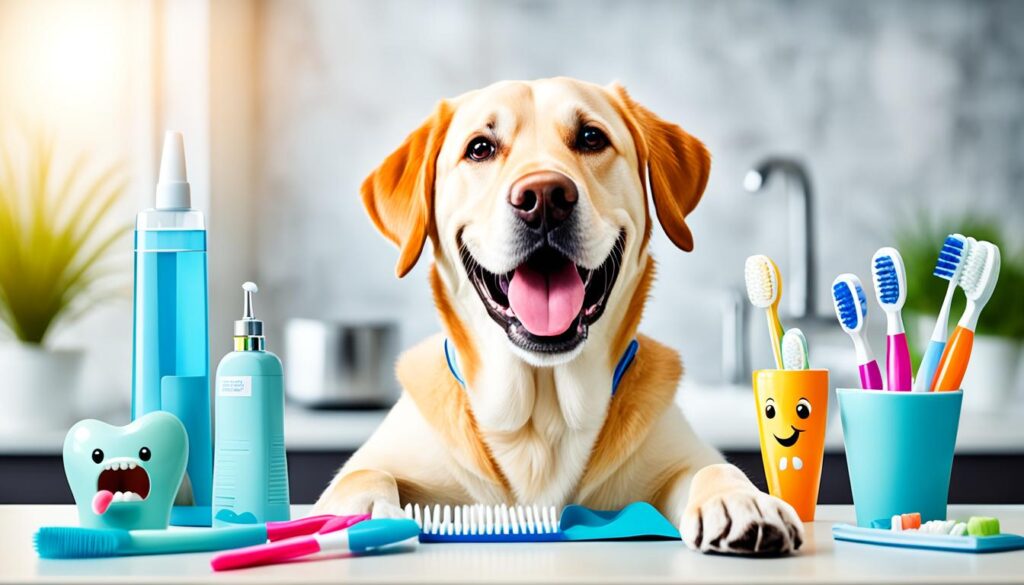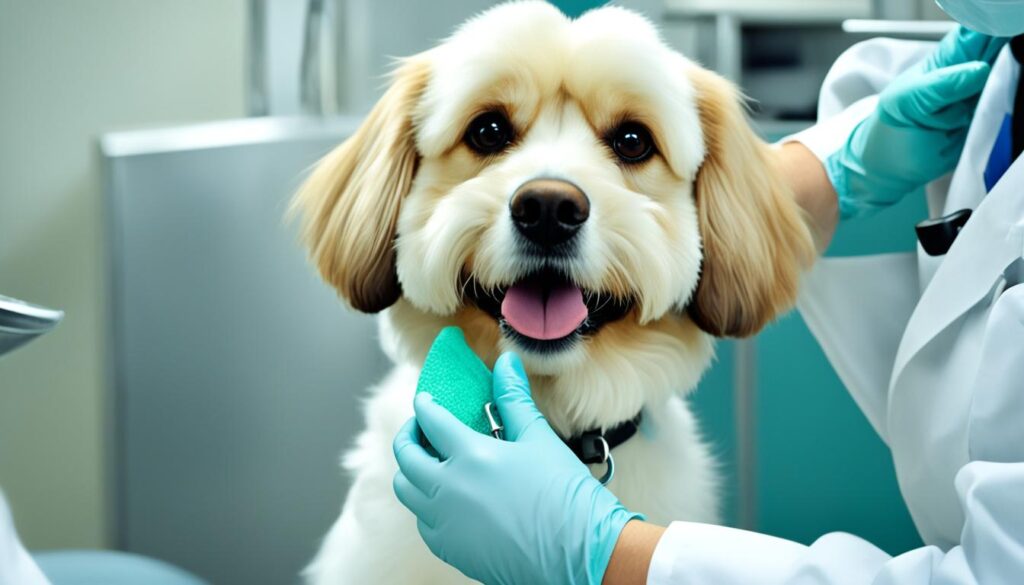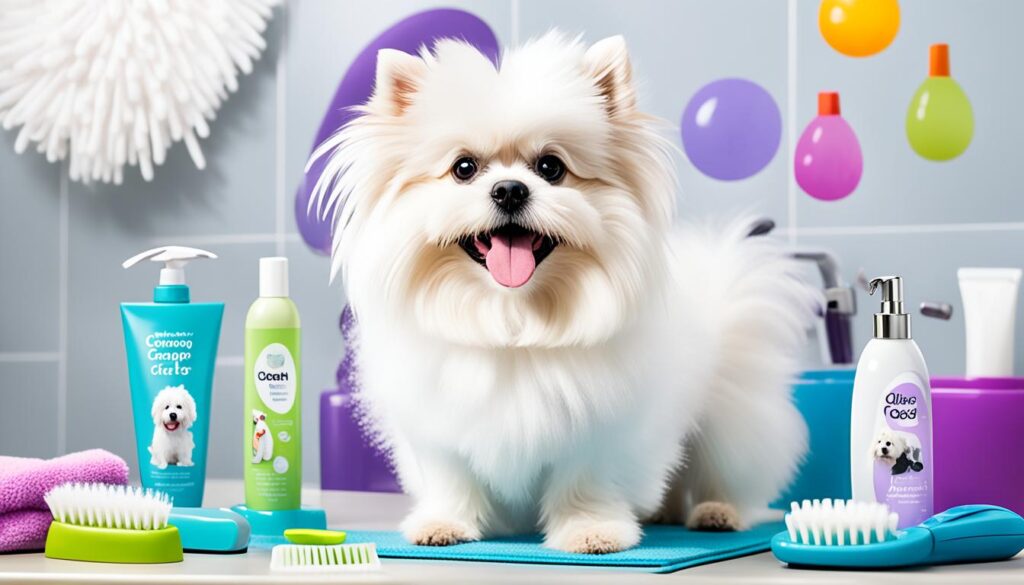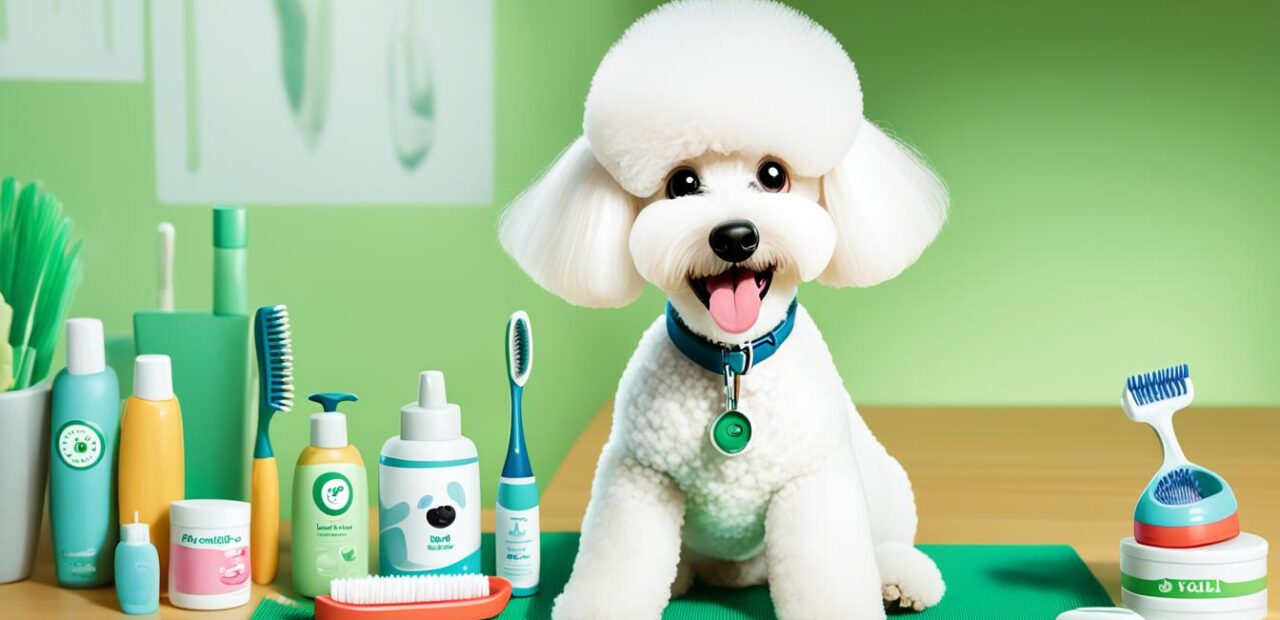Doggy Dental Hygiene: Brushing and Beyond
Did you know that 80% of dogs have some form of dental disease by the age of three? While regular brushing plays a crucial role in your dog’s dental hygiene, there’s more to it than meets the eye. A comprehensive grooming routine that includes proper teeth care, ear cleaning, paw and nail care, anal gland maintenance, eye care, and overall cleanliness contributes to your furry friend’s overall health and well-being. In this guide, we explore often overlooked grooming tasks that go beyond brushing to ensure your dog stays clean, healthy, and happy.
Key Takeaways:
- Regular brushing is essential for your dog’s dental hygiene.
- A comprehensive grooming routine includes teeth care, ear cleaning, paw and nail care, anal gland maintenance, eye care, and overall cleanliness.
- Proper grooming contributes to your dog’s overall health and well-being.
- 80% of dogs have some form of dental disease by the age of three.
- Taking care of your dog’s hygiene ensures their comfort and happiness.
Nurturing Healthy Ears: The Importance of Regular Cleaning
Ear health is often underestimated in grooming routines. While dog owners may focus on brushing their furry friend’s coat and teeth, the ears require attention as well. Regular ear cleaning is a crucial part of maintaining your dog’s overall well-being.
Signs of Ear Issues:
- Excessive scratching or rubbing of the ears
- Head shaking or tilting
- Redness or swelling of the ear canal
- Unpleasant odor from the ears
- Discharge or wax buildup
Identifying these signs can help you detect potential ear problems early on and seek appropriate veterinary care.
Step-by-Step Ear Cleaning Techniques:
- Gently restrain your dog, keeping them calm and comfortable.
- Inspect the ears for any signs of redness, discharge, or foul odor.
- Moisten a cotton ball or pad with a veterinarian-approved ear cleaning solution.
- Gently wipe the outer part of the ear, being careful not to insert it deeply into the ear canal.
- If necessary, use a clean cotton ball wrapped around your finger to reach the inner folds of the ear, again avoiding excessive insertion.
- Repeat the process on the other ear, using a new cotton ball or pad.
Regular ear cleaning can help prevent infections, reduce wax build-up, and maintain your dog’s auditory health. Remember, always consult your veterinarian if you notice any abnormalities or have concerns about your dog’s ears.
“Proper ear care plays a crucial role in your dog’s overall health. By regularly cleaning their ears, you can ensure their comfort and prevent potential complications.”
Shining a Spotlight on Dental Health: Tips for Effective Teeth Care
Dental care is a vital but sometimes neglected aspect of grooming for our furry friends. Just like humans, dogs also need proper dental hygiene to maintain a healthy mouth and overall well-being. In this section, we will explore the importance of dog dental care, effective brushing techniques, the benefits of dental treats, and how to keep your dog’s breath fresh.

Importance of Dog Dental Care
Good dental hygiene plays a crucial role in ensuring your dog’s overall health. Neglecting their dental care can lead to various oral problems, including plaque buildup, tartar formation, gum disease, and even tooth loss. It’s important to prioritize dental care to prevent potential pain and discomfort for your furry companion.
Brushing Techniques for Healthy Teeth
Regular brushing is one of the most effective ways to maintain your dog’s dental health. Here are some brushing techniques to keep in mind:
- Choose a toothbrush and toothpaste specifically designed for dogs.
- Gently introduce your dog to the toothbrush, gradually increasing the brushing time as they get used to it.
- Focus on the outside surfaces of the teeth, as that’s where plaque and tartar tend to accumulate.
- Use small circular motions to brush the teeth and gums.
- Reward your dog with praise or a dental treat after brushing to create a positive association.
The Benefits of Dental Treats
In addition to brushing, incorporating dental treats into your dog’s routine can provide extra care for their teeth. Dental treats are designed to promote chewing and help remove plaque and tartar buildup. Look for treats that have the Veterinary Oral Health Council (VOHC) seal of approval, indicating that they meet certain standards for promoting oral health.
Keeping Your Dog’s Breath Fresh
While fresh breath is important for your dog’s comfort, it’s also a sign of good oral health. Here are some tips for keeping your dog’s breath fresh:
- Offer dental treats that have natural breath-freshening ingredients.
- Consider adding a small amount of parsley or mint to your dog’s food, as these herbs can help freshen breath.
- Regularly check for signs of dental issues, such as bad breath, red or swollen gums, or difficulty chewing.
By following these dental care tips and incorporating them into your dog’s grooming routine, you can ensure their teeth stay healthy, their breath stays fresh, and they enjoy a happy, comfortable life.
| Dental Care Tips | Dogs Love |
|---|---|
| Regular brushing |
|
| Incorporating dental treats |
|
| Checking breath freshness |
|
Grooming the Paws and Nails: Beyond Aesthetic Concerns
Paw and nail care extends beyond aesthetic concerns—it’s crucial for your dog’s comfort and mobility. Proper paw and nail care contribute to your dog’s overall well-being and prevent potential health issues. In this section, we will explore the importance of dog paw care, the safe and effective way to trim nails, and how to pamper your dog’s paws.
Why Dog Paw Care Matters
Dog paw care is not just about keeping your pup’s paws clean and looking good. It plays a vital role in their overall health and mobility. Here are some essential reasons why dog paw care should be a part of your grooming routine:
- Comfort: Regular paw care helps prevent discomfort caused by overgrown nails, cracked paw pads, or foreign objects stuck between the toes.
- Mobility: Maintaining proper nail length ensures your dog can walk, run, and play without pain or difficulty.
- Prevention: By inspecting your dog’s paws regularly, you can identify any potential issues and address them before they become more serious.
The Safe and Effective Way to Trim Nails
Trimming your dog’s nails can be a daunting task, but with the right technique, it can be stress-free for both you and your furry friend. Follow these steps to trim your dog’s nails safely:
- Choose the right dog nail clippers or a nail grinder based on your dog’s size and comfort.
- Find a quiet and well-lit area where both you and your dog can feel relaxed.
- Hold your dog’s paw gently but firmly, ensuring their comfort and stability.
- Identify the quick, the pink area within the nail that contains blood vessels. Be careful not to cut into the quick, as it can cause bleeding and discomfort.
- Trim a small part of the nail at a time, using a steady and controlled motion.
- Offer treats and praise throughout the process to reward your dog for their cooperation.
If you’re unsure about trimming your dog’s nails, consult a professional groomer or your veterinarian for guidance.
Pampering Your Dog’s Paws
In addition to regular nail trims, pampering your dog’s paws can contribute to their overall paw health. Here are some ways to give your pup’s paws some extra TLC:
- Regularly inspect and clean your dog’s paws, removing any debris or foreign objects.
- Moisturize dry paw pads with a pet-safe paw balm or coconut oil to prevent cracks and discomfort.
- Provide comfortable bedding to give your dog’s paws a break and reduce the risk of pressure sores.
- Consider using dog booties or paw wax to protect your dog’s paws from extreme temperatures or rough surfaces.
Remember, taking care of your dog’s paws goes beyond aesthetics. It ensures their comfort, mobility, and overall well-being.
| Common Signs of Overgrown Nails | Health Risks of Overgrown Nails |
|---|---|
|
|
|
The Magic of Anal Gland Maintenance: A Discreet but Essential Task
Anal gland maintenance is often overlooked, yet it’s a vital part of grooming. Ensuring your dog’s anal glands are properly maintained is essential for their comfort and overall well-being. In this section, we will explore the reasons behind anal gland issues, how to identify signs of discomfort, and the techniques for expressing anal glands.
Understanding Anal Gland Issues
Anal gland issues can cause discomfort and even lead to more serious complications if left untreated. The anal glands, located on either side of your dog’s anus, produce a smelly liquid that helps with scent marking and communication. However, these glands can become impacted or infected, causing pain and discomfort for your furry friend.
- Signs of Anal Gland Issues: Keep an eye out for symptoms such as scooting, excessive licking or biting around the anal area, foul odor, and swelling near the anus.
- Common Causes: Anal gland issues can occur due to various reasons, including poor diet, lack of fiber, allergies, or underlying health conditions.
Expressing Anal Glands Safely
Expressing your dog’s anal glands is a discreet yet essential task that can provide immediate relief and prevent further complications. While it’s recommended to have a professional groomer or veterinarian perform this procedure, it’s helpful for dog owners to understand the process.
- Step 1: Find the Right Position: Position your dog in a comfortable and secure position, such as sitting or lying down.
- Step 2: Wear Protective Gloves: Put on disposable gloves to ensure hygiene and protect yourself from any potential infections.
- Step 3: Apply Gentle Pressure: Using a tissue or cotton ball, apply gentle pressure on both sides of the anal area to encourage the release of the gland’s contents.
- Step 4: Observe and Clean: After expressing the glands, observe the color, consistency, and odor of the liquid. If you notice any abnormalities, such as blood or a foul odor, consult a veterinarian.
Remember, if you are uncomfortable or unsure about expressing your dog’s anal glands, it’s always best to seek professional help to prevent any potential complications.

Proper anal gland maintenance is a discreet but essential task that contributes to your dog’s overall comfort and health. By understanding the signs of anal gland issues and learning the safe techniques for expressing anal glands, you can ensure your furry friend remains comfortable and avoids potential complications.
Checking and Caring for the Eyes: Clearing the Path to Health
Caring for your dog’s eyes goes beyond aesthetic appeal—it’s about maintaining ocular health. Just like humans, dogs can experience various eye issues that may require attention. By regularly checking and cleaning your dog’s eyes, you can help prevent discomfort and potential complications. Here are some signs to look out for and safe cleaning techniques to incorporate into your dog’s grooming routine:
Signs of Eye Issues
It is important to be vigilant and recognize any signs of eye issues that your dog may exhibit. Some common signs include:
- Excessive tearing
- Redness
- Swelling
- Discharge
- Squinting or blinking excessively
- Cloudiness or changes in the appearance of the eye
Safe Eye Cleaning Techniques
When it comes to cleaning your dog’s eyes, gentleness and caution are key to avoid causing discomfort or injury. Follow these steps for safe eye cleaning:
- Prepare a clean, damp cloth or a specially formulated eye wipe.
- Gently lift the upper eyelid and carefully wipe away any discharge or debris from the corner of the eye.
- Repeat the process for the lower eyelid.
- Use a separate part of the cloth or a new wipe for each eye to prevent cross-contamination.
- After cleaning, reward your dog with praise or a treat to create a positive association with the experience.
Regular eye cleaning should be part of your dog’s overall grooming routine. However, it’s important to note that if you notice persistent or worsening eye issues, it’s best to consult a veterinarian for a thorough examination and appropriate treatment.
Brushing Up on General Hygiene: Keeping the Coat, Skin, and Body Clean
While regular brushing is a fundamental part of your dog’s grooming routine, it’s important to go beyond that to ensure overall cleanliness. Maintaining a clean coat, healthy skin, and a fresh-smelling body is essential for your furry friend’s well-being. Here are some tips to help you achieve this:
Choosing the Right Grooming Products
When it comes to grooming your dog, selecting the right products is crucial. Consider your dog’s specific needs, such as their coat type and any skin sensitivities they may have. Look for high-quality shampoos, conditioners, and grooming tools that are gentle and suited for your dog’s unique requirements. Consulting with a professional groomer or your veterinarian can provide valuable guidance in choosing the right grooming products.
Understanding Your Dog’s Skin Type
Just like humans, dogs can have different skin types, ranging from dry to oily. Understanding your dog’s skin type will help you select the appropriate grooming products and establish an effective grooming routine. For dogs with dry skin, opt for moisturizing shampoos and conditioners that replenish moisture and prevent flakiness. If your dog has oily skin, choose products that control excessive oil production and keep the coat looking fresh and clean.
Maintaining a Clean Coat
A clean coat not only enhances your dog’s appearance but also promotes overall health. Regularly brushing your dog’s coat helps remove dirt, debris, and loose hairs, preventing matting and tangles. Additionally, it stimulates blood circulation and distributes natural oils, keeping the coat shiny and healthy. Depending on your dog’s breed and coat length, you may need to consider professional grooming services to ensure a thorough clean and trim if necessary.
Here’s a table summarizing the steps to maintain a clean coat:
| Step | Description |
|---|---|
| 1 | Regular brushing |
| 2 | Proper bathing and drying techniques |
| 3 | Promptly addressing any skin issues |
A Comprehensive Grooming Routine
Establishing and maintaining a comprehensive grooming routine is vital for your dog’s hygiene. In addition to brushing and maintaining a clean coat, this routine should include regular ear cleaning, nail trimming, dental care, and anal gland maintenance. These tasks contribute to your dog’s overall cleanliness, health, and well-being.

Remember, by prioritizing your dog’s grooming needs, you’re not only maintaining their hygiene but also keeping them comfortable and healthy. A well-groomed dog will not only look good but also feel good!
Conclusion
Incorporating regular tooth brushing into your dog’s routine is a simple yet impactful way to ensure their overall health and happiness. Maintaining good dog dental health goes beyond fresh breath – it plays a crucial role in your canine companion’s well-being.
While tooth brushing is essential, it can be complemented by the use of natural dental treats. These treats not only provide a delicious reward for your furry friend but also contribute to their dental hygiene. However, it’s important to note that dental treats are not a substitute for regular brushing.
There are some common dental health misconceptions that dog owners should be aware of. One such misconception is that bad breath in dogs is normal. In reality, bad breath may indicate underlying dental issues that require attention. Regular dental care can prevent dental diseases, ensuring your dog enjoys a longer, healthier life.
FAQ
Why is dental hygiene important for dogs?
Dental hygiene is essential for dogs because it helps maintain their overall health and well-being. Regular dental care, including brushing techniques and the use of dental treats, promotes healthy teeth and fresh breath.
What are the steps involved in cleaning a dog’s ears?
Cleaning a dog’s ears involves a step-by-step process. First, gather the necessary materials such as ear cleaning solution and cotton pads. Then, follow gentle techniques to remove dirt and debris from the ear canal. Regular ear cleaning helps prevent infections and maintains your dog’s auditory health.
How can I safely trim my dog’s nails?
Safely trimming your dog’s nails is important for their comfort and mobility. Start by getting your dog accustomed to nail trimming and use appropriate tools such as nail clippers or grinders. Take caution while trimming to avoid cutting the quick. Regular paw and nail care are crucial for your dog’s overall well-being.
What is the significance of anal gland maintenance?
Anal gland maintenance is often overlooked but is a vital part of grooming. Understanding the reasons behind anal gland issues and knowing how to express them is essential for your dog’s comfort and to prevent potential complications. Regular anal gland maintenance ensures your dog remains comfortable and avoids unnecessary problems.
How can I check and care for my dog’s eyes?
Checking and caring for your dog’s eyes is crucial for maintaining their ocular health. Learn how to check for signs of eye issues, safely clean around the eyes, and address common concerns. Proper eye care contributes to your dog’s overall comfort and vision health.
What should I consider when choosing grooming products for my dog?
When choosing grooming products for your dog, it’s important to consider their skin type and specific grooming needs. Understanding your dog’s skin type and using suitable products helps maintain a clean coat and healthy skin. Additionally, using the right grooming products contributes to a comprehensive grooming routine.
How does regular tooth brushing benefit my dog’s overall health?
Regular tooth brushing is a simple and impactful way to ensure your dog’s overall health and happiness. It helps prevent dental issues, such as plaque and tartar buildup, which can lead to more serious health problems. Incorporating dental treats and toys can also complement your dog’s dental care routine and contribute to their oral health.
Why are natural dental treats beneficial for dogs?
Natural dental treats are beneficial for dogs because they promote dental health while providing a tasty and satisfying reward. These treats help clean your dog’s teeth by reducing plaque and tartar buildup. Remember, a clean mouth is not just about fresh breath, but it’s also a step towards a longer, healthier life for your furry friend.


